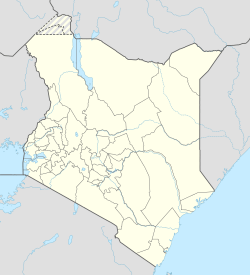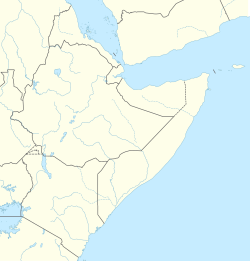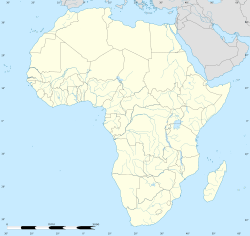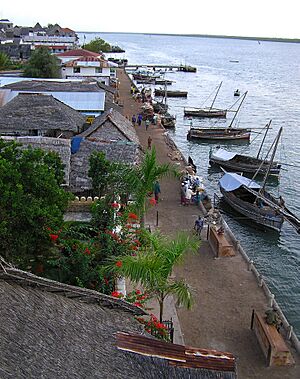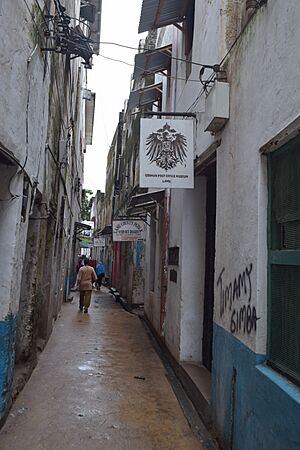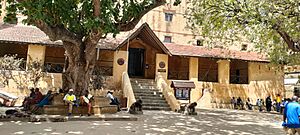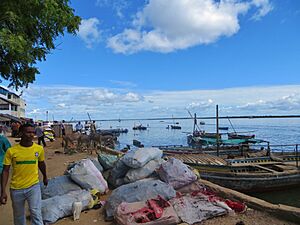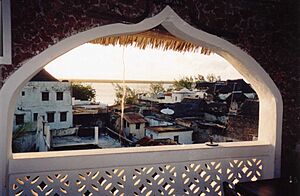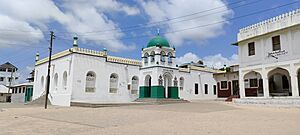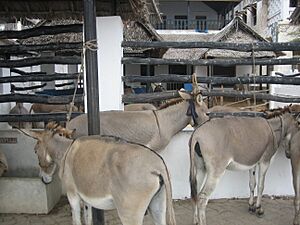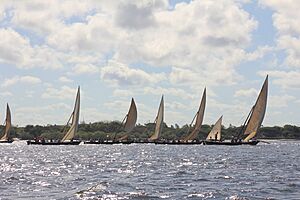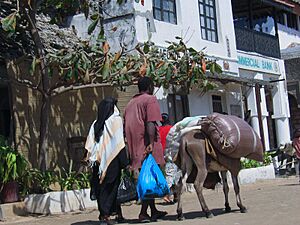Lamu facts for kids
Quick facts for kids
Lamu
|
|
|---|---|
|
Town
|
|
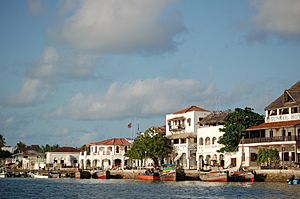 |
|
| Country | |
| County | Lamu County |
| Founded | 1370 |
| Population
(2019)
|
|
| • Total | 25,385 |
| Time zone | UTC+3 (EAT) |
| UNESCO World Heritage Site | |
| Official name | Lamu Old Town |
| Criteria | Cultural: (ii), (iv), (vi) |
| Inscription | 2001 (25th Session) |
| Area | 15.6 ha (39 acres) |
| Buffer zone | 1,200 ha (3,000 acres) |
Lamu or Lamu Town is a small, historic town. It is located on Lamu Island, which is part of the Lamu Archipelago in Kenya. Lamu is about 341 kilometers (212 miles) northeast of Mombasa by road. You reach it by crossing a sea channel from Mokowe Jetty.
Lamu is the main town of Lamu County. It is also a special place recognized by UNESCO as a World Heritage Site. The town has the Lamu Fort by the sea. It was started by the sultan of Pate in the early 1800s. Lamu also has 23 mosques, including the Riyadha Mosque built in 1900. There is even a special sanctuary for donkeys!
Contents
Discovering Lamu's Past
When Did Lamu Begin?
The town's first name was Amu. Arabs called it Al-Amu, and the Portuguese called it "Lamon." The Portuguese later used this name for the whole island. Lamu Town is Kenya's oldest town where people have lived continuously. It was one of the first Swahili settlements along the East African coast. People believe it was founded in 1370. Today, most people in Lamu are Muslim. An Arab traveler first wrote about Lamu in 1441. He met a judge from Lamu visiting Mecca.
Lamu and European Powers
In 1506, a Portuguese fleet arrived and made the king of Lamu pay them money every year. This was because Portugal wanted to control trade along the Indian Ocean. They had a strong hold on shipping and charged taxes on local trade. In the 1580s, Lamu rebelled against the Portuguese. Later, in 1652, Oman helped Lamu fight off Portuguese control.
Lamu's "Golden Age"
Lamu had its "golden age" from the late 1600s to the early 1800s. During this time, it was protected by Oman. Lamu was run by a group of elders called the Yumbe. They ruled from a palace in the town. Lamu became a center for poetry, politics, arts, crafts, and trade. Many of the town's beautiful buildings were built then. Lamu was also a place for learning. Women writers, like the poet Mwana Kupona, were respected.
In 1812, an army from Pate attacked Lamu. They wanted to capture the town and finish building its fort. But the local people fought back and stopped them. After this, Lamu asked Oman for soldiers to protect the area.
Lamu Under Colonial Rule
In the mid-1800s, Lamu came under the influence of the sultan of Zanzibar. Germany became interested in Lamu in 1885. They thought it was a good place for a base. From 1888 to 1891, Germany even had a post office in Lamu. It was the first one on the East African coast! Today, there's a museum about it. In 1890, Lamu became part of British colonial rule. Kenya became independent in 1963. Lamu still has some local freedom today.
Lamu in Modern Times
In 2010, a group called Global Heritage Fund said Lamu was one of 12 sites around the world at risk. They worried about damage due to not enough management and too much new building.
For a while, travel to Lamu was restricted because of safety concerns. But by early 2012, it was considered safe again. The US Department of State lifted its travel warning in April 2012.
Lamu's Weather
Lamu has a tropical dry savanna climate. This means it's generally warm all year. It has a wet season and a dry season.
Lamu's Economy and Trade
In the past, Lamu's economy relied on the trade of enslaved people until it was stopped in 1907. Other things traded from Lamu included ivory, wood from mangrove trees, turtle shells, and rhinoceros horn. These goods were sent across the Indian Ocean to the Middle East and India. When the Uganda Railroad was built in 1901, it started from Mombasa. This made Mombasa a bigger port and hurt Lamu's economy.
Today, tourism helps Lamu's economy a lot. Many visitors, especially backpackers, come to see the town. Local people often take tourists on trips in traditional dhow boats. Harambee Avenue is famous for its food. You can find halwa (sweet treats) and small mutton kebabs. Coconut, mango, grapefruit, and seafood like crab and lobster are common foods. The town has a central market and several shops.
The oldest hotel in Lamu is Petley's Inn, located by the water. Other hotels include Amu House, Bahari Hotel, and the Lamu Palace Hotel. The Stone House Hotel used to be an 18th-century house.
People in Lamu also harvest mangrove trees for building poles. There are many skilled craftspeople, like carpenters. They build boats and make beautiful doors and furniture. The town has the Lamu District Hospital, which is one of the best-equipped hospitals on the Kenyan coast.
A new, larger port is being built at Manda Bay. This Lamu Port is a big project. It aims to make Lamu a major shipping hub.
Important Places to See in Lamu
Lamu was founded in the 14th century. It has many great examples of Swahili architecture. The old city is a UNESCO World Heritage site. It is called "the oldest and best-preserved Swahili settlement in East Africa."
Lamu's population is diverse. It was a major trading point on Arabian routes. Because of this, most people in Lamu are Muslim. Visitors are asked to dress respectfully, covering more than just shorts or bikinis.
There are several museums in Lamu. These include the Lamu Museum, which has the island's special ceremonial horn called siwa. Other museums teach about Swahili culture and the local postal service. Here are some famous buildings in Lamu:
Lamu Fort: A Historic Stronghold
Lamu Fort is a fort right in the town. The sultan of Pate started building it by the sea. He wanted to protect his government, which wasn't very popular. He died in 1809, before the fort was finished. The fort was completed in the early 1820s.
Riyadha Mosque: A Center for Learning
Habib Salih, a respected religious teacher, came to Lamu in the 1880s. He taught many students. In 1900, the Riyadha Mosque was built. He introduced a special way of singing verses with tambourines. After he passed away in 1935, his sons continued his school. It became one of the most important places for Islamic studies in East Africa. The Mosque is the main place for the Maulidi Festival. This festival happens every year to celebrate the birth of the Prophet. People from many countries come to sing praises to Mohammad.
Lamu Donkey Sanctuary: Helping Animals
Lamu Island does not allow cars or other motor vehicles. So, donkeys do most of the heavy work and transportation. There are about 3,000 donkeys on the island! Dr. Elisabeth Svendsen from The Donkey Sanctuary in England visited Lamu in 1985. She was worried about the donkeys' health. So, the Sanctuary was opened in 1987. It gives free treatment to all donkeys.
Lamu's Rich Culture
Lamu hosts the Maulidi Festival in January or February. This festival celebrates Mohammed's birth. It includes fun activities like donkey races, dhow-sailing, and swimming competitions. The Lamu Cultural Festival is a colorful event usually held in late August. Since 2000, it has featured traditional dancing, crafts like kofia (hat) embroidery, and dhow races. The Donkey Awards, which give prizes to the best donkeys, happen in March or April. Women in Lamu perform the chakacha, a wedding dance. Men perform the hanzua (a sword dance) and wear kanzus (long robes).
Lamu Old Town became a UNESCO World Heritage site in 2001 for three main reasons:
- The buildings and town layout show how different cultures mixed over hundreds of years. These influences came from Europe, Arabia, and India. They used traditional Swahili building methods to create a unique culture.
- The rise and fall of seaports on the East African coast, and the mixing of Bantu, Arabs, Persians, Indians, and Europeans, was a very important time in the region's history. Lamu Old Town shows this best.
- Lamu was a very important trading center. It also attracted scholars and teachers. This gave Lamu a key religious role in the region, which it still has today.
Getting Around Lamu
In 2011, there were plans to build a deep-water port. This new port would be much bigger than Kenya's main port in Mombasa. It would allow more ships to arrive and leave at the same time.
Manda Airport is on Manda Island, near Lamu. It serves Lamu and the surrounding area. The airport is about 450 kilometers (280 miles) by air southeast of Nairobi International Airport. Several airlines fly to Manda, including Air Kenya and Safari Link. There are daily flights to Malindi, Mombasa, and Nairobi.
Famous People from Lamu
- Ustadh Mau (born 1952), a Muslim scholar, poet, and religious leader.
See also
 In Spanish: Lamu (Kenia) para niños
In Spanish: Lamu (Kenia) para niños


